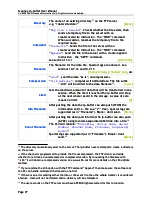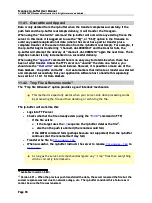
Scannex ip.buffer User Manual
© UK 2007-2021 Scannex Electronics Ltd. All rights reserved worldwide.
11.3. FTP Server
Username
The FTP server separates each channel with a different
username. When the FTP client software connects to the
ip.buffer it will see only this channel’s file in the
directory.
[Channel1]
,
[Channel2]
, etc
Password
The associated password
[password]
Filename
The filename for the channel.
[channel1.dat]
,
[channel2.dat]
, etc
Compression
“
none
” – send the data “as-is”, uncompressed
“
zlib deflate
” – compress with zlib deflate. The file suffix
“.zlib” will be added to the data filename.
[none]
Limit
Sets the maximum amount of data that will be transferred in one
session. When the limit is reached the ip.buffer will stop
at the next whole record in the storage.
[0]
Autodelete
“
No
” – the client must delete the data.
“
Delete after download
” – as soon as the ip.buffer sees that
the file has been successfully downloaded it will erase the
stored data.
[No]
Even if data is collected while logged into the FTP server, that data is not
immediately visible to the FTP client, and the client cannot delete that new
data. Issuing a “LIST” command (aka DIR) will “refreeze” the new data and
make it visible.
Only one FTP client is supported per channel. In other words, all channels can connect at
the same time, but two clients cannot connect into one channel – the FTP server will tell
the second client that it is busy.
(The same applies for channels that are configured to
collect
by FTP server. Each channel
can be used by only one FTP client device at a time.)
2
Both username and password are
case sensitive
!
3
If the channel is programmed to provide the file uncompressed, the FTP client can decide whether
to retrieve an uncompressed or compressed version. By requesting the filename with “.zlib” it will
obtain a compressed version. See www.zlib.net for more details on the
zlib deflate
method.
Page 94
Scannex ip.buffer User Manual
© UK 2007-2021 Scannex Electronics Ltd. All rights reserved worldwide.
11.3. FTP Server
Username
The FTP server separates each channel with a different
username. When the FTP client software connects to the
ip.buffer it will see only this channel’s file in the
directory.
[Channel1]
,
[Channel2]
, etc
Password
The associated password
[password]
Filename
The filename for the channel.
[channel1.dat]
,
[channel2.dat]
, etc
Compression
“
none
” – send the data “as-is”, uncompressed
“
zlib deflate
” – compress with zlib deflate. The file suffix
“.zlib” will be added to the data filename.
[none]
Limit
Sets the maximum amount of data that will be transferred in one
session. When the limit is reached the ip.buffer will stop
at the next whole record in the storage.
[0]
Autodelete
“
No
” – the client must delete the data.
“
Delete after download
” – as soon as the ip.buffer sees that
the file has been successfully downloaded it will erase the
stored data.
[No]
Even if data is collected while logged into the FTP server, that data is not
immediately visible to the FTP client, and the client cannot delete that new
data. Issuing a “LIST” command (aka DIR) will “refreeze” the new data and
make it visible.
Only one FTP client is supported per channel. In other words, all channels can connect at
the same time, but two clients cannot connect into one channel – the FTP server will tell
the second client that it is busy.
(The same applies for channels that are configured to
collect
by FTP server. Each channel
can be used by only one FTP client device at a time.)
2
Both username and password are
case sensitive
!
3
If the channel is programmed to provide the file uncompressed, the FTP client can decide whether
to retrieve an uncompressed or compressed version. By requesting the filename with “.zlib” it will
obtain a compressed version. See www.zlib.net for more details on the
zlib deflate
method.
Page 94











































